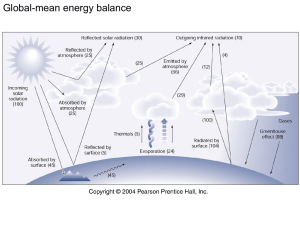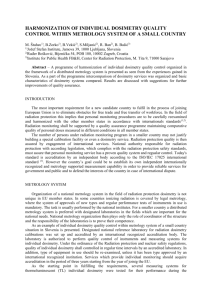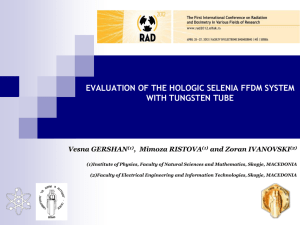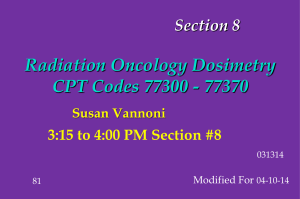Operation Tomodachi Individual Radiation Monitoring
advertisement
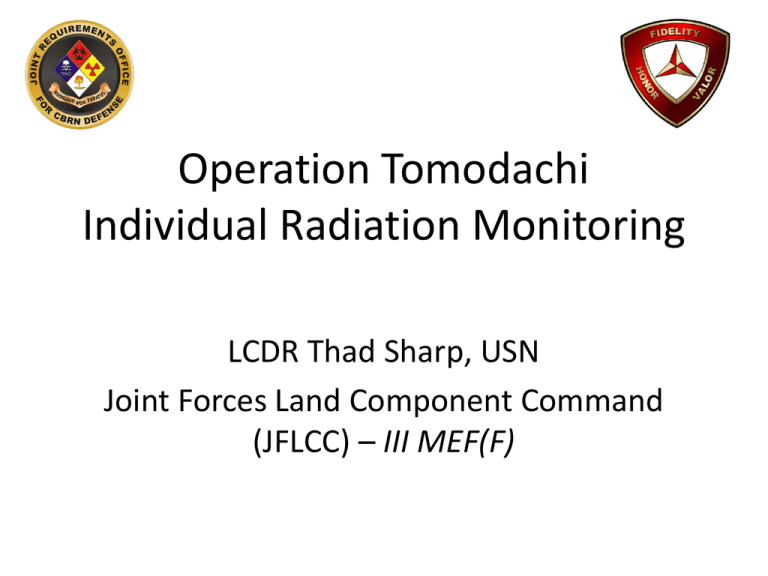
Operation Tomodachi Individual Radiation Monitoring LCDR Thad Sharp, USN Joint Forces Land Component Command (JFLCC) – III MEF(F) Outline • • • • • Radiation Monitoring Program intro CONOPS Execution Challenges Recommendations 2 Assignment Introduction • OPCON to Marine Corps Forces Pacific (MARFORPAC) • TACON to JFLCC (III MEF (Fwd)) • Augmented Force Surgeon and G-3 at MARFORPAC and Command Surgeon at JFLCC • Requested to support Operation Tomodachi as a radiation and decontamination SME 3 Radiation Monitoring Program Background • Commandant of the Marine Corps directed “all Marines in the effected area be monitored for radiation with a dose of record device” • MARFORPAC to perform radiation monitoring for Marines working ISO Operation Tomodachi • Requested approval from LTG Theissen for radiation monitoring plan prior to pushing forward to JFLCC in Japan 4 Planned CONOPS • Provide dose of record radiation monitoring for all Marines and DoD civilians working in the effected area • Monitor housing areas with posted dosimetry • Potentially monitor dependents • Navy DT-702 TLDs for use as primary dosimeter and Navy EPDs as secondary dosimeter for use in the hot zone 5 Challenges to Planned CONOPS • JFLCC is a Joint command with all Services represented • Plans developed by MARFORPAC were NOT coordinated with the forward command elements • MARFORPAC didn’t have all the information going forward • Air Force Radiation Assessment Team (AFRAT) arrived 2 days before my team 6 Revised Plan Execution • AFRAT issued NVLAP EPDs to all Service members per CG JFLCC direction • Instead of replacing Marine’s EPD with Navy TLDs, continued use of AFRAT EPDs – EPDs provide real-time digital readout • Psychological impact of replacing EPD with TLD (no real-time info) • AFRAT fell under JFLCC and provided dosimetry services 7 Revised Plan Execution Thermo MK2 EPD Navy DT-702 TLD 8 Challenges • • • • Personnel Movement EPD vice TLD Service Specific Dosimetry Higher HQ Guidance 9 Challenges – Personnel Movement • For Navy RHOs – Many RHOs are in 1 of 1 billets – Some resistance to give up RHOs for deployment – No clear plan once the members arrived in country, for example: • Where they were to be assigned • Who exactly to report to • What their mission was going to be – Medical Planners did not seek requirements guidance from forward command elements 10 Challenges – Personnel Movement • AFRAT and USTRANSCOM problems – The AFRAT sat at Wright Patterson AFB for several days waiting on transportation 11 Challenges – Personnel Movement • Travel orders/DTS/GOVCC/SATO issues – Original orders were for ship conditions • Mission changed before even getting to Hawaii – Not all SATO offices can help with TAD travel – Orders amendment required for partial payment to GOVCC (TAD >45 days) – GOVCC credit limit not high enough for extended overseas TAD 12 Challenges – EPD vs. TLD • Thermoluminescent Dosimeter (TLD) – Very common device for recording a radiation “dose of record” (primary dosimeter) – Provides no real-time readings to the user – Must be sent back to home lab to be read – Much lower cost per unit compared to EPD 13 Challenges – EPD vs. TLD • Electronic Personal Dosimeter (EPD) – Becoming more widely used as a primary dosimeter if NVLAP accredited – Provides digital, real-time information to the user – Can be confusing with regards to NVLAP accredited device or not • It’s the process and not just the EPD that is accredited • CBRN Marine’s DMR-2000 EPD is neither a calibrated nor accredited dosimeter – To date, only AFRAT has NVLAP accredited EPDs 14 Challenges - Service Specific Dosimetry • Army, Navy, and Air Force all have different dosimetry systems (OSL, Harshaw, Panasonic) – All work very well for specific Service requirements • All Services have different methods of storing the permanent radiation dose in medical records and archives • Not conducive to a Joint operation in a radiological environment 15 Challenges - Service Specific Dosimetry • Resistance from all three Service Dosimetry Centers on the use of one common primary dosimeter for all Service members assigned to the JFLCC • One Service still badged personnel with their specific dosimetry – Created a “double badging” problem 16 Challenges – Higher HQ Guidance • Guidance was 300 mrem/operation – Most JTF personnel had TLDs not EPDs • Dosimetry guidance: – Confusing – Delayed – Conflicting • JFLCC had to develop and execute plans without higher command guidance 17 Recommendations • Develop and deploy a Joint radiation dosimeter for use in Joint operations – Needs to be NVLAP accredited – Easily integrated by all Services – Lightweight – Rugged and EMP hardened – LLD in the microrem range, i.e. ~10 urem/h – Provide real-time and long term exposure info 18 Recommendations • Evaluate and update training on equipment for radiation and nuclear events for CBRN Marines – Specific training for proper contamination surveys – More in-depth radiation safety training • Biological effects of ionizing radiation • Radiation and contamination detection principles and equipment • Basic health physics and math related to radiation safety 19 The Way Ahead • The JRO-CBRND has begun the collaborative efforts for writing a Capabilities Development Document (CDD) for a Joint Expeditionary Radiation Dosimetry System 20






